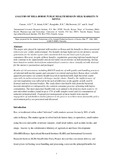| dc.contributor.author | Staal, S | |
| dc.contributor.author | McDermott, J J | |
| dc.contributor.author | Kang'ethe, E K | |
| dc.contributor.author | Arimi, S M | |
| dc.contributor.author | Omore, A O | |
| dc.date.accessioned | 2013-06-13T12:40:12Z | |
| dc.date.available | 2013-06-13T12:40:12Z | |
| dc.date.issued | 2002-05-09 | |
| dc.identifier.citation | Omore, A.O.; Arimi, S.M.; Kang’ethe, E.K.; McDermott, J.J.; Staal, S. 2002. Analysis of milk-borne public health risks in milk markets in Kenya. Paper presented at the annual symposium of the Animal Production Society of Kenya, 9-10 May 2002, KARI-NAHRS, Naivasha, Kenya. Nairobi (Kenya): ILRI | en |
| dc.identifier.uri | http://hdl.handle.net/11295/33119 | |
| dc.identifier.uri | http://erepository.uonbi.ac.ke:8080/xmlui/handle/123456789/33119 | |
| dc.description.abstract | The major role played by informal milk markets in Kenya and the benefits to those associated with it are now widely acknowledged. The benefits include higher prices for farmers, income generation for the market agents and convenient delivery and lower prices for poor consumers. However, in spite of these benefits, regulations governing informal marketing of milk continue to be unfavourable and do not reflect local realities of milk marketing, having been based on models derived from industrialised countries where virtually all milk destined for the market is pasteurised and packaged. Results of risk assessment, including HACCP analysis, of milk quality and handling practices of informal milk market agents and consumers in central and southern Kenya show variable apparent prevalence of zoonotic health hazards in marketed milk, high bacterial counts especially in outlets associated with longer market chains. Notably, the ineffectiveness of current regulations was reflected in the lack of difference in the quality of milk sold by licensed and non-licensed traders. The study shows that health risks from the bacterial hazards identified are mitigated by the common consumer practice of boiling milk before consumption. The most important health risks were judged to be from two main sources: (i) anti-microbial residues found in up to 15% of milk samples tested and (ii) consumption of naturally fermented milk. Proposals for management of these health risks and the engagement of stakeholders and key players in the process to achieve more favourable policy environment policy are presented and discussed. | en |
| dc.language.iso | en | en |
| dc.subject | Public Health | en |
| dc.subject | Milk Hygiene | en |
| dc.subject | Markets | en |
| dc.subject | Kenya | en |
| dc.title | Analysis of milk-borne public health risks in milk markets in Kenya | en |
| dc.type | Article | en |
| local.publisher | Department of Public Health | en |

